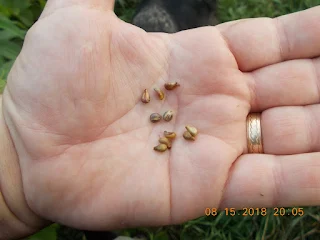 |
| Seeds from three different grape cultivars. Seeds on top are from Noiret (berry weight of about 3 grams). Seeds in the middle are from Riverbank Grape (berry weight of 0.7 grams). Seeds on the bottom are from Lucie Kuhlmann (berry weight of 1.3 grams). |
 |
| Two selections of Vitis riparia, Riverbank Grape, on 3" by 5" cards for size reference. Cluster on the right is L-50s, a low acid selection from Minnesota. Cluster on the left is from a random, wild, Michigan vine. The L-50s cluster weighed 32 grams and the native Michigan cluster weighed 25 grams. |
 |
| Ten large berries from L-50s weighed 7.2 grams. |
 |
| The seeds from those ten berries weighed 1.3 grams or 18% of the berry's weight. |
 |
| The stems weighed 2.1 grams or 6.6% of the cluster weight. |
 |
| The seeds will be dried using Dr L. Pittman's method of mixing them with ample amounts of corn meal that has been thoroughly desicated in a common microwave oven. |
Making some very coarse assumptions here:
- That the majority of the energy in the flesh is contained as soluble solids at 24% solids
- That the stems are 50% water by weight
- That the seeds are 45% water, 50% carbohydrates and 5% lipids
We can rough out the following "energy budget" for Vitis riparia L-50s:
- 60% of the energy invested by the plant in producing the cluster of V. riparia L-50s is contained in the flesh
- 30% of the energy invested in producing the cluster of V. riparia L-50s is contained in the seeds
- 10% of the energy invested in the cluster is contained in the stems.
Were it possible to produce seedless
V. riparia L-50s berries, it would be possible to increase the yield of flesh by 40% by simple re-budgeting of the energy. Note that the reciprocal of 70% (100%- the 30% invested in the seeds) is 1.4. While eliminating the seeds might not be practical, breeders can increase the effective yield by selecting for larger berries which usually tilts the flesh/seed ratio in a favorable direction.
From a landscaping for wildlife standpoint, the seeds contain a significant portion of the energy originally invested by the plant into the cluster. Even if the berries are completely dried out and leached by fall rains, the retained berries still present a significant amount of energy to birds migrating northward in the spring by virtue of the carbohydrates and oils in the seeds.






https://www.sciencedaily.com/releases/2018/08/180803160207.htm
ReplyDeleteHere is some hope seeds can be short cut.
Joe, I am interested in Herb Fritzke's L-50S grape.
ReplyDeleteDo you know where one can still obtain seed or cuttings of this grape? Any help is appreciated, thanks!
Send your address to one.time.use.erj@gmail.com
DeleteI can send you some cuttings.
Do you want any Swenson Red or anything else?
Joe, I forgot to ask if you are growing the L-50S grape, or if there are vineyards near you that are growing it. Thanks!
ReplyDelete